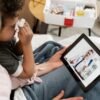As we enter the year 2023, the healthcare industry is poised to experience a wave of transformative changes that will revolutionize how we approach the field of medicine. With breakthrough discoveries and cutting-edge innovations on the horizon, the stage is set for an exciting era of healthcare that promises to be more effective, efficient, and affordable than ever before.
This article will take a closer look at some of the key medical technology trends and transformations. These trends are expected to shape the future of healthcare in the coming years.
With a focus on preventing and predicting diseases rather than simply treating them at advanced stages, these trends aim to boost the quality and accessibility of healthcare services while driving down costs.
So, without further ado, let us get straight to the topic.
1. Artificial Intelligence and Machine Learning:
Artificial intelligence (AI) and machine learning are rapidly becoming a growing trend in the healthcare industry. These technologies can transform the healthcare industry, from improving diagnosis and treatment to forecasting. It can analyze large amounts of patient data, including medical images, electronic health records (EHRs), and other health data.
For example, machine learning algorithms can analyze medical images such as X-rays and MRIs to identify potential health issues, such as tumors or other abnormalities helping healthcare providers to make more accurate diagnoses and develop more effective treatment plans.
Bioinformatics division adopts machine learning for gene sequence analysis. Machine learning algorithms are used to predict the functions of genes based on their DNA sequences and can identify patterns in the reverse complement associated with specific biological functions.
Another area where AI and machine learning are making an impact on healthcare is drug discovery. AI and machine learning algorithms can identify potential drug candidates more efficiently than traditional methods, helping researchers to find the most appropriate medicine combinations.
2. Remote Patient Monitoring:
Remote Patient Monitoring (RPM) is an emerging trend in the healthcare industry that allows healthcare providers to monitor patients remotely using connected medical devices. It enables doctors and nurses to track patients’ vital signs, health metrics, and other pertinent information without requiring patients to visit a healthcare facility.
RPM can help reduce hospital readmissions and emergency room visits by up to 38%.
Remote Patient Monitoring devices can monitor patients with chronic conditions such as heart disease and diabetes and provide timely alerts if any concerning symptoms arise. It has improved patient outcomes by providing more personalized care, reducing the risk of adverse events, and increasing patient engagement and adherence to treatment plans.
3. The Internet of Medical Things (IoMT)
The Internet of Medical Things (IoMT) refers to a network of medical devices and applications that can connect to the internet and share information with healthcare providers.
IoMT is a rapidly growing trend in the healthcare industry that involves connecting medical devices, wearables, and other healthcare technologies to the internet. It allows the collection and analysis of real-time data, enabling healthcare providers to make more informed decisions and provide better patient care.
The Internet of Medical Things is valuable because it helps healthcare providers make more informed decisions about their care. For example, if you have a heart condition, your doctor might give you a wearable device that monitors your heart rate and alerts you if something seems off.
4. Cloud-Based Solutions
Cloud-based solutions have emerged as a major trend in the healthcare industry in recent years, offering numerous benefits to healthcare providers and patients. They enhance flexibility and accessibility and enable healthcare providers to access patient information anywhere on any device.
Another advantage of cloud-based solutions is increased data security and privacy. By storing patient data in the cloud, healthcare providers can better protect health information from security breaches and cyber-attacks.
5. Cybersecurity and Data Privacy:
A weekly average of 626 attacks was recorded against healthcare organizations at the end of 2021, and that number is still rising today.
To address these risks, healthcare providers are implementing a range of cybersecurity and data privacy measures. This includes everything from network security protocols and encryption technologies to employee training and risk assessments.
Healthcare providers are also working to ensure compliance with regulations such as the Health Insurance Portability and Accountability Act (HIPAA) and the General Data Protection Regulation (GDPR), which govern patient data privacy and security.
The use of artificial intelligence (AI) and machine learning (ML) is also becoming increasingly prevalent in the field of cybersecurity and data privacy. These technologies can help healthcare providers detect and respond to cyber threats more quickly and effectively by identifying potential vulnerabilities and risks.
6. Big Data & Analytics:
The healthcare industry generates enormous data daily, from electronic health records (EHRs) to medical images and clinical notes. The industry is implementing big data and analytics technologies to sort out data and extract insights to enhance patient outcomes, cut costs, and drive innovation.
Advanced technologies such as predictive analytics, real-time monitoring, and precision medicine can help healthcare providers provide better patient care while increasing operational efficiency.
By analyzing massive amounts of patient data, they can identify patterns and predict future outcomes, allowing them to identify high-risk patients, predict readmission rates, and tailor treatment plans.
Precision medicine offers personalized treatment plans that cater to the individual needs of each patient, while real-time monitoring of patients’ data allows healthcare providers to detect potential problems early and intervene before they become serious.
Finally, by analyzing data from hospital operations, healthcare providers can identify inefficiencies and take steps to optimize staffing levels, reduce wait times, and improve patient flow. This will result in better patient outcomes and lower costs.
Conclusion:
The healthcare industry is poised to undergo a technological revolution, with artificial intelligence, telemedicine, and wearables at the forefront of the transformation. Despite challenges like data privacy and security, the significant benefits of these innovations cannot be ignored.
Going forward, it is crucial for healthcare providers, tech companies, and policymakers to collaborate to utilize these advances responsibly and ethically. By doing so, we can create a healthier and brighter future for everyone.










